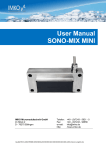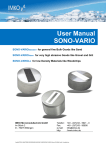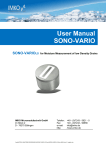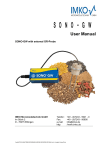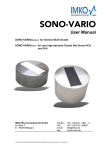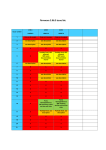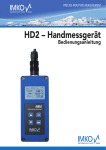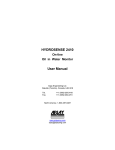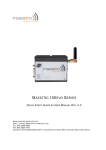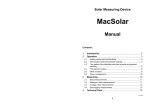Download User Manual SONO-MIX MINI
Transcript
User Manual SONO-MIX MINI IMKO Micromodultechnik GmbH Im Stöck 2 D - 76275 Ettlingen Telefon: Fax: e-mail: http: +49 - (0)7243 - 5921 - 0 +49 - (0)7243 - 90856 [email protected] //www.imko.de I:\publik\TECH_MAN\TRIME-SONO\ENGLISH\SONO-MIX MINI\Manual SONO-MIX-MINI_Vers2_5-english.docx 2/45 User Manual for SONO-MIX MINI th As of 15 October 2015 Thank you for buying an IMKO moisture probe. Please carefully read these instructions in order to achieve best possible results with your mixer probe SONO-MIX MINI for the in-line moisture measurement in sand, gravel, fresh concrete or any other material. Should you have any questions or suggestions regarding your new mixer probe after reading, please do not hesitate to contact our authorised dealers or IMKO directly. We will gladly help you. List of Content 1. Instrument Description SONO-MIX MINI ................................................................................... 4 ® 1.1.1. The patented TRIME TDR-Measuring Method ............................................................. 4 ® 1.1.2. TRIME compared to other Measuring Methods ............................................................ 4 1.1.3. Areas of Application ........................................................................................................ 4 1.2. Mode of Operation .................................................................................................................. 5 1.2.1. Measurement Values with physically Pre-check, Average Value and Filtering .............. 5 1.2.2. Auto-Correction at Abrasion ............................................................................................ 5 1.2.3. Determination of the Cement Concentration .................................................................. 5 1.2.4. Material Temperature Measurement............................................................................... 5 1.2.5. Temperature compensation of the internal SONO-electronic ......................................... 6 1.2.6. Analogue Outputs ........................................................................................................... 6 1.2.1. The serial IMP-Bus interface ........................................................................................... 7 1.2.2. The IMP-Bus as a user friendly network system ............................................................ 7 1.2.3. Error Reports and Error Messages ................................................................................. 8 2. Configuration of the Measure Mode .......................................................................................... 9 2.1. Cyclic operation modes CA, CF, CH, CC and CK ................................................................. 9 2.1.1. Average Time in the measurement mode CA and CF .................................................. 11 2.1.2. Filtering at material gaps in mode CA and CF .............................................................. 11 2.1.3. Mode CC – automatic summation of a moisture quantity during one batch process ... 13 2.1.4. Mode CH – Automatic Moisture Measurement in one Batch ...................................... 14 2.2. Overview of single modes for different applications ............................................................. 15 2.3. Calibration of SONO-MIX MINI in a mixing plant ................................................................. 16 2.3.1. Shortest expecting mixing times and density effects at partial loads ........................... 19 2.3.2. SONO-MIX to control the water/cement ratio ............................................................... 19 3. Calibration Curves ..................................................................................................................... 20 3.1.1. SONO-MIX MINI for measuring Moisture of Sand and Aggregates ............................. 23 3.2. Creating a linear Calibration Curve for a specific Material ................................................... 24 3.2.1. Nonlinear calibration curves .......................................................................................... 24 4. Connectivity to SONO Probes .................................................................................................. 26 4.1.1. Connection Plug and Plug Pinning ............................................................................... 27 4.1.2. Analogue Output 0..10V with a Shunt-Resistor ............................................................ 28 4.1.3. Connection diagram with SONO-VIEW ........................................................................ 28 5. Installation of the Probe ............................................................................................................ 29 5.1. Assembly Instructions .......................................................................................................... 29 3/45 5.2. Assembly Dimensions .......................................................................................................... 30 5.1. Installation of the SONO-MIX MINI inside a Screw Conveyor ............................................. 31 5.1.1. Installation of the SONO-MIX MINI in a mobile Mixer Truck ........................................ 31 6. Connection of the Probe to the SM-USB Module from IMKO ............................................... 32 7. Quick Guide for the Commissioning Software SONO-CONFIG.................................................. 34 7.1.1. Scan of connected SONO probes on the serial interface ............................................. 34 7.1.2. Configuration of Measure Mode and serial SONO-interface ........................................ 35 7.1.3. Set analogue outputs of the SONO probe .................................................................... 35 7.1.4. Selection of the individual Calibration Curves .............................................................. 36 7.1.5. “Test” run in the respective Measurement Mode .......................................................... 38 7.1.6. “Measure” Run in Datalogging-Operation ..................................................................... 38 7.1.7. Basic Balancing in Air and Water .................................................................................. 39 7.1.8. Offsetting the material temperature sensor .................................................................. 40 7.1.9. Compensation of the electronic temperature ............................................................... 40 8. TECHNICAL DATA SONO-MIX MINI ......................................................................................... 41 4/45 1. Instrument Description SONO-MIX MINI ® 1.1.1. The patented TRIME TDR-Measuring Method The TDR technology (Time-Domain-Reflectometry) is a radar-based dielectric measuring procedure at which the transit times of electromagnetic pulses for the measurement of dielectricity constants, respectively the moisture content are determined. The SONO-MIX MINI Mixer Probe consists of a high grade steel casing with a wear-resistant sensor head made of hardened steel and ceramic. An integrated TRIME TDR measuring transducer is installed into the casing. A high frequency TDR pulse (1GHz), passes along wave guides and generates an electro-magnetic field around these guides and herewith also in the material surrounding the probe. Using a new patented measuring method, IMKO has achieved to -12 measure the transit time of this pulse with a resolution of 1 picosecond (1x10 ), consequently determine the moisture and to provide information in regard to the concrete composition. The established moisture content, as well as the concrete composition, respectively the temperature, can either be uploaded directly into a SPC via two analogue outputs 0(4)...20mA or recalled via a serial interface. ® 1.1.2. TRIME compared to other Measuring Methods ® In contrary to conventional capacitive or microwave measuring methods, the TRIME technology (Time-Domain-Reflectometry with Intelligent Micromodule Elements) does not only enable the measuring of the moisture but also to verify if the cement content specified in a recipe has been complied with. This means more reliability at the mixing fresh concrete. TRIME-TDR technology operates in the ideal frequency range between 600MHz and 1,2 GHz. Capacitive measuring methods (also referred to as Frequency-Domain-Technology) , depending on the device, operate within a frequency range between 5MHz and 40MHz and are therefore prone to interference due to disturbance such as the temperature and the mineral contents of the measured material. Microwave measuring systems operate with high frequencies >2GHz. At these frequencies, nonlinearities are generated which require very complex compensation. For this reason, microwave measuring methods are more sensitive in regard to temperature variation. SONO probes calibrate themselves in the event of abrasion due to a novel and innovative probe design. This consequently means longer maintenance intervals and, at the same time, more precise measurement values. The quality of fresh concrete is the decisive factor for the stability and the durability of concrete constructions. Hereby, the two parameters moisture and cement content assume a central role as these determine the consistency and the desired mechanical stability of concrete. The measurement of these two basic parameters therefore warrant for ideal quality and durability. SONO-MIX MINI accurately measures both in the dry mixture and in the wet mixture. A "dry mixture" can e.g. be mixed with residual water varying solids content so that the water content to 70% target is met. The remaining 30% clean water content can then be dosed with SONO-MIX MINI precisely. 1.1.3. Areas of Application The SONO-MIX MINI mixer probe is suited for installation into intensive mixers and chutes and other plant technologies. 5/45 1.2. Mode of Operation 1.2.1. Measurement Values with physically Pre-check, Average Value and Filtering SONO probes measure internally at very high cycle rates of 10 kHz and update the measurement value at a cycle time of 250 milliseconds at the analogue output. In these 250 milliseconds a probeinternal pre-check of the moisture values is already carried out, i.e. only plausible and physically checked and pre-averaged single measurement values are be used for the further data processing. This increases the reliability for the recording of the measured values to a downstream control system significantly. In the Measurement Mode CS (Cyclic-Successive), an average value is not accumulated and the cycle time here is 250 milliseconds. In the Measurement Mode CA, CF or CK, not the momentarily measured individual values are directly issued, but the average value is accumulated via a variable number of measurements (Average) in order to filter out temporary variations. These variations can be caused by inhomogeneous moisture distribution in the material surrounding the sensor head. The delivery scope of the SONO-MIX MINI includes suited parameters for the averaging period and a universally applicable filter function deployable for currently usual applications. The time for the average value accumulation, as well as various filter functions, can be adjusted for special applications. 1.2.2. Auto-Correction at Abrasion Even in the event of abrasion at the probe head of a SONO probe, the automatic measurement compensation enables significantly longer operating periods without the necessity of recalibration. Many other probes deployed for the material moisture measurement are equipped with a dielectric screen (ceramic or plastic plate). If this screen is exposed to wear and a regular recalibration is not conducted, these probes will provide faulty measurement values as the intensity of the measuring field subsequently increases due to the wear. At the SONO series with the TRIME TDR radar-based method, the innovative probe design ensures for the automatic correction of the sensor in case of changes to the dielectric screen caused by abrasion. This consequently means continuous reliability and longer maintenance intervals at the SONO probes. 1.2.3. Determination of the Cement Concentration With the radar-based TRIME measurement method, it is now possible for the first time, not only to measure the moisture, but also to provide information regarding the conductivity, respectively the cement content, the expansion rate or the composition of a special material. Hereby, the attenuation of the radar pulse in the measured volume fraction of the material, e.g. fresh concrete, is determined. This novel and innovative technology measures the same amount of material as with the moisture measurement and delivers a radar-based conductance value (EC-TRIME Radar-based-Conductivity) in dS/m. EC-TRIME is a characteristic value which is determined in dependency of the cement concentration, respectively the water/cement ratio and is issued as an unscaled value. The EC-TRIME measurement range of the SONO-MIX MINI is 0..50dS/m. 1.2.4. Material Temperature Measurement A temperature sensor is installed into the SONO-probe which establishes the casing temperature 3mm beneath the sensor surface. The temperature can optionally be issued at the analogue output2. As the TRIME electronics operates with a power of approximately 1.5 W, the probe casing does slightly heat up. A measurement of the material temperature is therefore only possible to a certain degree. The material temperature can be determined after an external calibration and compensation of the sensor self-heating. The offset of the measured temperature value can be adjusted with help of the program SONO-CONFIG. Despite SONO probes show a generally low temperature drift, it could be necessary to compensate a temperature drift in special applications. SONO probes offer two possibilities for temperature compensation. 6/45 Temperature compensation for the measured material Water and special materials like oil fruits and others, can show a dependency of the dielectric permittivity when using SONO probes at high temperature ranges. The dielectric permittivity is the raw parameter for measuring water content with SONO probes. If special materials show a very special temperature drift, e.g. in lower temperatures a higher drift than in higher temperatures, than it could be necessary to make a more elaborate temperature compensation. Therefore it is necessary to measure in parallel the material temperature with the temperature sensor which is placed inside the SONO probe. Normally this is related with high efforts in laboratory works. SONO probes offer the possibility to set special temperature compensation parameters t0 to t5 for every calibration curve Cal1 of Cal15 (see chapter “Selection of the individual calibration curve”). Please contact IMKO should you need any assistance in this area. 1.2.5. Temperature compensation of the internal SONO-electronic With this method of temperature compensation, a possible temperature drift of the SONO-electronic can be compensated. Because the SONO-electronic shows a generally low temperature drift, SONO probes are presetted at delivery for standard ambient conditions with the parameter TempComp=0.2. Dependent on SONO probe type, this parameter TempComp can be adjusted for higher temperature ranges (up to 120°C for special version) to values up to TempComp=0.75. But it is to consider that it is necessary to make a Basic-Balancing of the SONO probe in air and water, if the parameter TempComp is changed to another value as TempComp=0.2. The parameter TempComp can be changed with the software tool SONO-CONFIG, in the menu "Calibration" and the window "Electronic-Temperature-Compensation". Attention: When changing the TempComp parameter, a new basic balancing of the SONO probe is necessary! 1.2.6. Analogue Outputs The measurement values are issued as a current signal via the analogue output. With the help of the service program SONO-CONFIG, the SONO probe can be set to the two versions for 0..20mA or 4..20mA. Furthermore, it is also possible to variably adjust the moisture dynamic range e.g. to 0-10%, 0-20% or 0-30%. For a 0-10V DC voltage output, a 500R resistor can be installed in order to reach a 0..10V output. Analogue Output 1: Moisture in % (0…20%, variable adjustable) Analogue Output 2: Conductivity (EC-TRIME) or optionally the temperature. In addition, there is also the option to split the analogue output 2 into two ranges: into 4..11mA for the temperature and 12..20mA for the conductivity. The analogue output two hereby changes over into an adjustable one-second cycle between these two (current) measurement windows. For the analogue outputs 1 and 2 there are thus two adjustable options: Analog Output: (two possible selections) 0..20mA 4..20mA For very special PLC applications, the current output can be also inverted into: 20mA...0mA or 20mA…4mA Analogue Output Channel 1: SONO-MIX MINI offers only analogue output1 Analogue output2 is not connected! The analogue outputs of the SONO probe can be adjusted into one to four possible selections. 7/45 1. Moist, Temp Analogue output 1 for moisture, output 2 for material temperature. 2. Moist, Conduct Analogue output 1 for moisture, output 2 for conductivity in ranges of 0..20dS/mS or 50dS/m 3. Moist, Temp/Conductivity Analogue output 1 for moisture, output 2 for both, temperature and conductivity (ECTRIME) with an automatic current-window change in cycles of 5 seconds. 4. Moist / MoistSTdDev Analogue output 1 for moisture, output 2 for the standard deviation based on the single moisture values. This function is useful in e.g. fluid bed drier for air volume control. Adjustment for the Measurement Ranges For analogue output 1 and 2 the moisture dynamic range and temperature dynamic range can be variably adjusted. The moisture dynamic range should not exceed 100% Moisture Range: Temp. Range: Maximum: e.g. 20 for sand (Set in %) Maximum: 70 °C Minimum: 0 Minimum: 0 °C Conductivity Range: 0..20dS/m or 0…50dS/m Dependent on probe type and moisture range, SONO probes can measure pore water conductivities (EC-TRIME) in ranges of 5dS/m up to 50dS/m. 1.2.1. The serial IMP-Bus interface SONO-MIX MINI is equipped with the IMP-Bus interface to set and readout individual parameters or measurement values. An easy to implement data transfer protocol enables the connection of several sensors/probes at the serial interface. In addition, SONO-probes can be directly connected via the module SM-USB or the display module SONO-VIEW to the USB port of a PC, in order to adjust individual measuring parameters or conduct calibrations. Please consider: The initial default setting of the serial interface is pre-setted for the IMP-Bus. In the Support area of IMKO´s homepage www.imko.de we publish the transmission protocol of the SONO-probes. 1.2.2. The IMP-Bus as a user friendly network system With external power supply on site for the SONO probes, a simple 2-wire cable can be used for the networking. By use of 4-wire cables, several probes can be also supplied with power. Standard RS485-interfaces cause very often problems! The RS485 is usually not galvanically isolated and therefore raises the danger of mass grindings or interferences which can lead to considerably security problems. An RS485 network needs shielded and twisted pair cables, especially for long distances. Depending on the topology of the network, it is necessary to place 100Ohm termination resistors at sensitive locations. In practice this means considerable specialist effort and insurmountable problems. 8/45 The robust IMP-Bus ensures security. SONO-probes have in parallel to the standard RS485 interface the robust galvanically isolated IMP-Bus which means increased safety. The serial data line is isolated from the probe´s power supply and the complete sensor network is therefore independent from single ground potentials and different grid phases. Furthermore the IMP-Bus transmit its data packets not as voltage signals, but rather as current signals which also works at already existing longer cables. A special shielded cable is not necessary and also stub lines are no problem. 1.2.3. Error Reports and Error Messages SONO probes are very fault-tolerant. This enables failure-free operation. Error messages can be recalled via the serial interface. 9/45 2. Configuration of the Measure Mode The configuration of SONO- probe is preset in the factory before delivery. A process-related later optimisation of this device-internal setting is possible with the help of the service program SONOCONFIG. For all activities regarding parameter setting and calibration the probe can be directly connected via the serial interface to the PC with SM-USB-Module or the SONO-VIEW display module which are available from IMKO. The following settings of SONO probes can be amended with the service program SONO-CONFIG: Measurement-Mode and Parameters: Measurement Mode A-On-Request (only in network operation for the retrieval of measurement values via the serial interface). Measurement Mode C Cyclic: SONO-VARIO is supplied ex-factory with suited parameters in Mode CH for measuring moisture of sand and gravel. For other applications, mode CA could be usable. Up to 6 different modes can be adjusted: Mode CS: (Cyclic-Successive) For very short measuring processes (e.g. 2…10 seconds) without floating average and without filter functions, with internal up to 100 measurements per second and a cycle time of 250 milliseconds at the analogue output. Measurement mode CS can also be used for getting raw data from the SONO-probe without averaging and filtering. Mode CA: (Cyclic-Average-Filter) For relative short measuring processes with continual average value, filtering and an accuracy of up to 0.1% Mode CF: (Cyclic-Float-Average) for continual average value with filtering and an accuracy of up to 0.1% for very slowly measuring processes, e.g. in fluidized bed dryers, conveyor belts, etc. Mode CK: (Cyclic-Kalman-Filter with Boost) Standard setting for SONO-MIX for use in fresh concrete mixer with continual average value with special dynamic Kalman filtering and an accuracy of up to 0.1%. Mode CC: (Cyclic Cumulated) with automatic summation of a moisture quantity during one batch process. Mode CH: (Cyclic Hold) similar to Mode CC but without summation. Mode CH is recommended for applications in the construction industry. If the SONOprobe is installed under a silo flap, Mode CH can measure moisture when batch cycles are very short, down to 2 seconds. Mode CH executes an automatic filtering, e.g. if dripping water occurs. Each of these settings will be preserved after shut down of the probe and is therefore stored on a permanent basis. 2.1. Cyclic operation modes CA, CF, CH, CC and CK For the cyclic modes the SONO probes are supplied ex-factory with suited parameters for the averaging time and with a universally deployable filter function suited for most currently applications. The setting options and special functions of SONO probes depicted in this chapter are only rarely required. It is necessary to take into consideration that the modification of the settings or the realisation of these special functions may lead to faulty operation of the probe! For applications with non-continuous material flow, there is the option to optimise the control of the measurement process via the adjustable filter values Filter-Lower-Limit, Filter-Upper-Limit and the time constant No-Material-Keep-Time. The continual/floating averaging can be set with the parameter Average-Time. 10/45 Parameters in the Measurement Mode CA, CF, CC, CH and CK Function Average-Time Standard Setting: 2s Setting Range: 1…20 Unit: Seconds CA/CF: Time (in seconds) for the generation of the average value can be set with this parameter. CC/CH/CK: Setting of the time for calculation of the trend or expectation value for the Boost & Offset function. Filter-Upper-Limit-Offset Standard Setting: 25% Setting Range: 1….20 Unit: % Absolut CA/CC/CF/CH/CK: Too high measurement values generated due to metal wipers or blades are filtered out. The offset value in % is added to the dynamically calculated upper limit. Filter-Lower-Limit-Offset Standard Setting: 25% Setting Range: 1.….20! Unit: % Absolut CA/CC/CF/CH/CK: Too low measurement values generated due to insufficient material at the probe head are filtered out. The offset value in % is subtracted from the dynamically calculated lower limit with the negative sign. Upper-Limit-Keep-Time Standard Setting: 10 Setting Range: 1...100 Unit: % Absolut CA/CC/CF/CH/CK: The maximum duration (in seconds) of the filter function for Upper-Limit-failures (too high measurement values) can be set with this parameter. Lower-Limit-Keep-Time Standard Setting: 10 Setting Range: 1...100s Unit: Seconds CA/CC/CF/CH/CK: The maximum duration (in seconds) of the filter function for Lower-Limit-failures (too low measurement values) for longer-lasting "material gaps", ie the time where no material is located on the probe´s surface can be bridged. Moisture Threshold (start threshold in %-moisture) Standard Setting: 0.1% Setting Range: 0….100% Unit: % Absolut CA/CF/CK: inactive CC/CH: The accumulation of moisture values starts above the „Moisture Threshold“ and from here the analogue signal is outputted. The accumulation pauses and will be frozen if the moisture level is below the threshold value. The No-MaterialDelay time starts and material gaps (disturbance) can be eliminated. No-Material-Delay (period time) Standard Setting: 10s Setting Range: 1….100s Unit: Seconds CA/CF/CK: inactive CC/CH: The accumulation stopps if the moisture value is below the Moisture Threshold. The accumulation pauses for the period of the setted delay time and will be frozen if the moisture level is below the threshold value. The SONO probes starts again in a new batch with a new accumulation after the setted time span of the “No-Material-Delay” is completely exceeded. Boost Standard Setting: 35nn Setting Range: 1….100nn Unit: without unit! CA/CF: inactive CC/CH/CK: Defines, how strong single measurement values are weighted dependent on deviation to the current expected average value. With e.g. Boost=35, a single measurement value is weighted with only 65% (100-35) for a new average value. Offset Standard Setting: 0.5% Setting Range: 0 ….5% Unit: % Absolut CA/CF: inactive CC/CH/CK: Non-linearities in the process can be compensated by higher weighting of higher values. Can be used e.g. in fluid bed dryers or under silo flaps where non-linearities can occur due to changes in the material density during process. “Offset” works together with the parameter “Average-time”. Weight Standard Setting: 5 values CA/CF/CK: inactive CH: Smoothing factor for analog output setting. This parameter 11/45 Setting Range: 0 …..50 Unit: Measurement Values influences the reaction/response time with factor 3. E.g. 15 values responds to a reaction time of 15/3=5 seconds. CK: The reaction/response time works nearly 1:1. E.g. 15 values responds to a reaction time of 15 seconds. Invalid Measure Count Standard Setting: 2 values Setting Range: 0….. 10 Unit: Measurement Values with 3 single values per second. CA/CF/CK: inactive CC/CH: Number of discarded (poor) measurement values after the start of a new batch, when „No-Material-Delay“ has triggered. The first measurement values will be rejected, e.g. due to dripping water. Moisture Std. Deviation Count Standard Setting: 5 values Setting Range: 0….. 20 Unit: Measurement Values with 3 single values per second. CA/CC/CF/CH/CK: If the parameters Temperature or EC-TRIME (RbC) are not needed, the analogue output 2 can be setted tot he mode Moist/Moist Std. Deviation. In this mode the standard deviation of all single moisture values can be outputted. With this function the homogeneity of the single measurement values can be determined and it is possible to control a regulating process, e.g. pressure regulation. Quick und Quick-Precision With Meas Time (no. values) Unit: without unit! CA/CC/CF/CH/CK/CS: Recommended is Quick Precision with Meas Time=2 where the TDR pulse is detected precisely. For still a little better accuracies, Meas Time can be increased, however the single measurement cycle is increased by 60 milliseconds per step (e.g. from 280ms to 340ms). Older SONO probe versions do not have this Quick Precision function! 2.1.1. Average Time in the measurement mode CA and CF SONO probes establishes every 200 milliseconds a new single measurement value which is incorporated into the continual averaging and issues the respective average value in this timing cycle at the analogue output. The averaging time therefore accords to the “memory” of the SONO probe. The longer this time is selected, the more inert is the reaction rate, if differently moist material passes the probe. A longer averaging time results in a more stable measurement value. This should in particular be taken into consideration, if the SONO probe is deployed in different applications in order to compensate measurement value variations due to differently moist materials. At the point of time of delivery, the Average Time is set to 4 seconds. This value has proven itself to be useful for many types of applications. At applications which require a faster reaction rate, a smaller value can be set. Should the display be too “unstable”, it is recommended to select a higher value. 2.1.2. Filtering at material gaps in mode CA and CF A SONO probe is able to identify, if temporarily no or less material is at the probe head and can filter out such inaccurate measurement values (Filter-Lower-Limit). Particular attention should be directed at those time periods in which the measurement area of the probe is only partially filled with material for a longer time, i.e. the material (sand) temporarily no longer completely covers the probe head. During these periods (Lower-Limit-Keep-Time), the probe would establish a value that is too low. The Lower-Limit-Keep-Time sets the maximum possible time where the probe could determine inaccurate (too low) measurement values. Furthermore, the passing or wiping of the probe head with metal blades or wipers can lead to the establishment of too high measurement values (Filter-Upper-Limit). The Upper-Limit-Keep-Time sets the maximum possible time where the probe would determine inaccurate (too high) measurement values. Using a complex algorithm, SONO probes are able to filter out such faulty individual measurement values. The standard settings in the Measurement Mode CA and CF for the filter functions depicted 12/45 in the following have proven themselves to be useful for many applications and should only be altered for special applications. It is appropriate to bridge material gaps in mode CA with Upper- and Lower-Limit Offsets and KeepTime. For example the Lower-Limit Offset could be adjusted with 2% with a Lower-Limit Keep-Time of 5 seconds. If the SONO probe determines a moisture value which is 2% below the average moisture value with e.g. 8%, than the average moisture value will be frozen at this value during the Lower-Limit Keep-Time of 5 seconds. In this way the material gap can be bridged. This powerful function inside the SONO probe works here as a highpass filter where the higher moisture values are used for building an average value, and the lower or zero values are filtered out. In the following this function is described with SONO parameters. Sufficient material for an accurately moisture measurement value of e.g.8% Material gaps over e.g. 3 seconds which must be bridged for an accurately measurement with a Lower-Limit Keep-Time of 5 seconds. The following parameter setting in mode CA fits a high pass filtering for bridging material gaps. The Filter Upper-Limit is here deactivated with a value of 20, the Filter Lower-Limit is set to 2%. With a Lower-Limit Keep-Time of 5 seconds the average value will be frozen for 5 seconds if a single measurement value is below the limit of 2% of the average value. After 5 seconds the average value is deleted and a new average value building starts. The Keep-Time function stops if a single measurement value lies within the Limit values. 13/45 2.1.3. Mode CC – automatic summation of a moisture quantity during one batch process Simple PLCs are often unable to record moisture measurement values during one longer batch process with averaging and data storage. Furthermore there are applications without a PLC, where accumulated moisture values of one batch process should be displayed to the operating staff for a longer time. Previously available microwave moisture probes on the market show two disadvantages: 1. Such microwave probes need a switching signal from a PLC for starting the averaging of the probe. This increases the cabling effort. 2. Material gaps during one batch process will lead to zero measurement values which falsify the accumulated measurement value considerably, recipe errors can occur. Unlike current microwave probes, SONO probes work in mode CC with automatic summation, where it is really ensured that the measured material has contact with the probe. This increases the reliability for the moisture measurement during one complete batch process. The summation is only working if material fits at the probe. Due to precise moisture measurement also in the lower moisture range, SONO probes can record, accumulate and store moisture values during a complete batch process without an external switching or trigger signal. The SONO probe “freezes” the analogue signal as long as a new batch process starts. So the PLC has time enough to read in the “freezed” moisture value of the batch. For applications without a PLC the “freezed” signal of the SONO probe can be used for displaying the moisture value to a simple 7-segment unit as long as a new batch process will start. With the parameter Moisture Threshold, the SONO probe can be configured to the start moisture level where the summation starts automatically. Due to an automatic recalibration of SONO probes, it is ensured that the zero point will be precisely controlled. The start level could be variably set dependent to the plant. Recommended is a level with e.g. 0.5% to 1%. With the parameter No-Material-Delay a time range can be set, where the SONO probe is again ready to start a new batch process. Are there short material gaps during a batch process which are shorter than the “No-Material-Delay”, with no material at the probes surface, then the SONO probe pauses shortly with the summation. Is the pause greater as the “No-Material-Delay” then the probe is ready to start a new batch process. Please note: If the PLC already accumulates single moisture values in higher cycle rates, than an additional automatic summation of a moisture quantity inside the SONO-probe during one batch process will produce errors. Here mode CS is recommended. How can the mode CC be used, if the SONO probe cannot detect the „moisture threshold“ by itself, e.g. above a conveyor belt if there is constant material covering above the probe head over a longer time: In this case, a short interrupt of the probe´s power supply, e.g. for about 0.5 seconds with the help of a relay contact of the PLC, can restart the SONO probe at the beginning of the material transport. After this short interrupt the SONO probe starts immediately with the summarizing and averaging. Please note: It should be noted that no material sticks on the probes surface. Otherwise the moisture zero point detection of the probe will be shifted up and the probe would not be detect a moisture low value below the “Moisture-Threshold”. 14/45 Time chart for mode CC 2.1.4. Mode CH – Automatic Moisture Measurement in one Batch Mode CH can be used for applications in the construction industry. If the SONO-probe is installed under a silo flap, Mode CH can measure moisture when batch cycles are very short, down to 5 seconds (and perhaps shorter). Mode CH executes an automatic filtering with Invalid Measure Count, e.g. if dripping water occurs or for filtering out the first false measurements after opening the silo flap. The measurement cycle starts if the probe detects the Moisture Threshold value and freeze the analogue output value until the next cycle. 15/45 2.2. Overview of single modes for different applications The following table gives an overview about possible parameter settings in different modes: Application/ Installation and specific Parameters Sand/ Gravel under a silo flap Above a conveyor belt Inside a mixer Inside a fluid bed dryer Generally simple applications in a screw conveyor with filtering options due to metal spiral At the end of a screw conveyor Long term process Operating Mode CH CH CK CK CA CK CF AverageTime 2 2 5 5 10 10 30 FilterUpper-Limit Offset inactiv 100 inactiv 100 inactiv 100 inactiv 100 e.g. 20 inactiv 100 e.g. 20 FilterLower-Limit Offset inactiv 100 inactiv 100 inactiv 100 inactiv 100 e.g. 10 inactiv 100 e.g. 5 UpperLimit-KeepTime inactiv 10 inactiv 10 inactiv 10 inactiv 10 e.g. 10 inactiv 10 e.g. 10 LowerLimit-KeepTime inactiv 10 inactiv 10 inactiv 10 inactiv 10 e.g. 10 inactiv 10 e.g. 10 Moisture Threshold 0.1 0.1 0.1 0.1 - 0.1 - No-MaterialDelay 10 10 10 10 - inactiv - Boost 35 35 20 20 - 20 - Offset 0.5 0.5 1 1 - 1 - Weight 5 5 25 25 - 50 - Invalid Measure Count 2 2 inactiv inactiv - inactiv - For very difficult applications, where it is not certain, which mode is the best, we recommend to select mode CA with averaging time = 1 second. With help of the software SONO-CONFIG a data record can be stored directly during process conditions. After forwarding this data set to IMKO, we would be pleased to be at your disposal for finding the best suitable working mode. 16/45 2.3. Calibration of SONO-MIX MINI in a mixing plant SONO-MIX MINI is delivered with a raw calibration function which is far higher than the real moisture values (kiln dried values) of a sand/gravel or fresh concrete mixture. The reason is that SONO-MIX use a powerful modified filter algorithm, which would work incorrect at Zero-values (division by zero results in infinite). Therefore it is necessary with SONO-MIX, (as well as with all other moisture probes), to make a recipe specific calibration with the PLC in the mixing plant. Another reason for this calibration is that every mixer type has another behaviour concerning the raw density of the mixed material. In practice, a mixer moisture probe has to be calibrated with two points in the mixing plant. The first calibration point should be relatively dry, e.g. at 2 to 3% gravimetric moisture. The second point should be in a range which matches the maximum moisture value in practice, e.g. 5%. The closely together these both moisture-values1 and 2 are, the higher could be the measurement error due to the reference measurement, especially at moisture values which are beyond of these two points or not between these two points! Following process can be recommended: 1. Record measurement values in the PLC for a dry mixture of one cubic meter, i.e. the mixture has a relative low water content. It is recommended to average the values of the PLC over the last 5 seconds of the dry mixing time. In this example a measurement value of 8126 has been recorded with the PLC: Measurement values with dry mixture SONO-MIX Measurement values (current signal from 4…20mA) Measurement value in a PC 5.968 mA 3.2 (in % moisture) Digit Value of A/D-Converter PLC without unit from 0 to max. 32768 digits 8126 This is the Dry-value-A/D Water content 17/45 2. Add water manually into the dryer mixture, e.g. 20.0 liter water. The added and measured water content is later used for the calculation of the c1-Sensitivity of the SONO-MIX for this recipe. When the mixture has a stable consistency, than record the measurement values with the PLC in the more wet mixture. It is recommended to average the values over the last 5 seconds of the mixing time. In this example a measurement value of 10811 has been recorded with the PLC. SONO-MIX Measurement values (current signal from 4…20mA) Measurement value in a PC (without unit) Digit Value of A/D-Converter PLC without unit from 0 to max. 32768 digits Measurement values of dry mixture 7.968 mA 6.2 8126 This is the Dry-value-A/D Measurement values of more wet mixture 7.232mA 4.3% 10811 This is the more wet value-A/D This is the PLC value where the concrete mixture has exactly 20.0 liter more water inside. Note: For prefab concrete with higher flow spread, it is recommended to record the wet measurement values without concrete plasticizer in the mixture. The reason is that the plasticizer modifies the density of the fresh concrete considerably, which leads to deviations in the measurement values. 3. Determination of the Sensitivity of the SONO-MIX for this recipe: For calibration and calculation of the mixing water for further mixtures, the coefficient c1-Sensitivity of the SONO-MIX can be calculated easily in the following way: c1-Sensitivity = (10811 – 8126) / 20.0 liter = 134.25 digits PLC per liter water Attention: This sensitivity is a value for the concrete volume which is used in this procedure for e.g. 1.0 cubic meter concrete. For higher or partial volumes it is necessary to calculate the added water content up or down, dependent on the volume. Because the SONO-MIX measures moisture precise also with different grain size distribution, it is possible to calculate with a standard c1-Sensitivity for similar recipes. For very different recipes, e.g. recipes with coloring agents or other added special materials it is recommended to check the c1Sensitivity and if necessary determine a new c1-Sensitivity. 18/45 Following draft shows the parameters at different mixer volumes with 0.8 cubic meter and 1.0 cubic meter: To come to the standard parameter liter per (one) cubic meter, the result with liter per 0.8 cubic 3 meter can be calculated to one cubic meter. I.e. 64 Liter / 0,8 = 80 Liter/m . If a volume of e.g. 1.5 cubic meter was used, following calculation will result: 3 120 Liter / 1,5 = 80 Liter/m To come and compare the exact water content values per cubic meter inside the mixture, it is possible to take a (representative) sample out of the mixer for kiln drying. weight of water The moisture is calculated by: Moisture in % = -------------------------- * 100% weight complete Whereby the weight of water results in the difference of the weight complete before and after the kiln drying. The exact water content in liter per cubic meter of the mixture can be calculated with the moisture value 3 and the raw density of the mixture. This results with e.g. 3% moisture and 1700kg/m raw density in: 3 Water content in liter/m = (moisture in %) * (raw density) / 100 = 3,0 * 1700 / 100 = 51 Liter/m Typical raw densities for sand, gravel and concrete mixtures are: 3 Pure sand: approx. 1500 kg/m 3 Sand/gravel mixture: approx. 1700 kg/m 3 3 Sand/gravel/cement mixture: dependent on water content between 2000kg/m und 2400kg/m A precise measurement of the raw density of the sand/gravel mixture can be done with standard sample cubes. 3 19/45 2.3.1. Shortest expecting mixing times and density effects at partial loads Time to evaluate signal at dry mix stage The sensor can be configured depending on the requirements of the applications, but in the presetting it requires 15-20s till the value is stable after filling the mixer with aggregates and cement. Time to evaluate signal at wet mix stage The sensor will immediately detect the incoming water, but commonly it lasts a little till the water is distributed homogeneous, thus we suggest not to have shorter wet mixing time than 45s. Does density have an effect on accuracy If the mixer load varies from 20% to 100% of total mixer capacity, it needs to calibrate for different loads. At 20% load, the sensor could experience no material or less material Different density does always have an effect and on any sensor, operating with an electrical field, but how strong this effect is depends on the installation place in the mixer, as closer to the wall of the mixer, as less this effect is, as due to the mixing energy with smaller batches more material is located at the outside of the mixer. But it always has to be ensured, that at least one mixing tool cleans the sensor per turn, to ensure the sensor stays clean! Even if close to the wall you will see at least a slight effect of the filling amount. 2.3.2. SONO-MIX to control the water/cement ratio SONO-MIX can be also used to control the w/c-ratio by determination of the moisture respectively the water content at the end of the mixing process. Similar as described in the previous chapter, a recipe specific calibration with the PLC in the mixing plant can be made at the end of the mixing process with the final fresh concrete. Depending to the concrete recipe the probe has to be calibrated with two points in the mixing plant, however this two points shall lie in a closer and higher moisture range, e.g. between 7% to 8% due to the concrete type. With the determined moisture or water content and the known cement content, the w/c-ratio can be calculated. It should be considered, that the PLC should calculate the moisture content with several single values over 3 to 5 seconds shortly before the discharge of the mixture. 20/45 3. Calibration Curves SONO-MIX MINI is supplied with the calibration curve Cal9 MIX for the mixer operation with sand and gravel. Cal9 MIX is slightly increased in the dry measurement range to ensure that in dry sand and gravel, the readings do not move to 0% values, because values around 0% can be disadvantageous for the filter arithmetic. So in dry sand/gravel the readings of the SONO-MIX MINI show higher measurement values. For an absolute value calculation for the water addition into the mixer it is important to take this into account. In general, the calibration of the probe for the water addition by a PLC has to be determined with laboratory measurement methods (oven drying). A maximum of 15 different calibration curves (Cal1 ... Cal15) are stored inside the SONO probe and can optionally be activated via the program SONO-CONFIG. If SONO-MIX MINI is used without mixer operation, only for measuring the moisture content of aggregates like sand and gravel, then the calibration curve Cal. 1 (Universal Sand Mix) must be set. If SONO-MIX MINI isn´t used inside a mixer but e.g. beneath a flap, the operation mode must be changed from CK to CA. A preliminary test of an appropriate calibration curve (Cal1. .15) can be activated in the menu "Calibration" and in the window “Material Property Calibration" by selecting the desired calibration curve (Cal1...Cal15) and with using the button “Set Active Calib”. The finally desired and possibly altered calibration curve (Cal1. .15) which is activated after switching on the probes power supply will be adjusted with the button "Set Default Calib”. Nonlinear calibrations are possible with polynomials up to 5th grade (coefficients m0 to m5). IMKO publish on its website more suitable calibration coefficients for different materials. These calibration coefficients can be entered and stored in the SONO probe by hand (Cal14 and Cal15) with the help of SONO-CONFIG. The following charts (Cal.1 .. 15) show different selectable calibration curves which are stored inside the SONO probe. On the y-axis the gravimetric moisture (MoistAve) is shown. On the x-axis depending on the calibration curve the associated radar time tpAve in picoseconds is shown. With the software SONOCONFIG the radar time tpAve is shown on the screen parallel to the moisture value MoistAve (see "Quick Guide for the Software SONO-CONFIG). 21/45 22/45 23/45 3.1.1. SONO-MIX MINI for measuring Moisture of Sand and Aggregates The TRIME-TDR technology with the radar method offers high reliability for measuring moisture of sand and aggregates, as different grain sizes, unlike other measurement techniques such as microwave technology, do not cause any distortion of the measurement result. The calibration curve Cal1 "Universal Sand Mix" is suitable for measuring the moisture in bulk sand, gravel and gravel/sand granulates. The deviations for the below listed gravel/sand types to the universal calibration curve Cal1 are so low that only one single calibration curve may be used. 24/45 3.2. Creating a linear Calibration Curve for a specific Material The calibration curves Cal1 to Cal15 can be easily created or adapted for specific materials with the help of SONO-CONFIG. Therefore, two measurement points need to be identified with the probe. Point P1 at dried material and point P2 at moist material where the points P1 and P2 should be far enough apart to get a best possible calibration curve. The moisture content of the material at point P1 and P2 can be determined with laboratory measurement methods (oven drying). It is to consider that sufficient material is measured to get a representative value. Under the menu "Calibration" and the window "Material Property Calibration" the calibration curves CAL1 to Cal15 which are stored in the SONO probe are loaded and displayed on the screen (takes max. 1 minute). With the mouse pointer individual calibration curves can be tested with the SONOprobe by activating the button "Set Active Calib". The measurement of the moisture value (MoistAve) with the associated radar time tpAve at point P1 and P2 is started using the program SONO-CONFIG in the sub menu "Test" and "Test in Mode CA" (see "Quick Guide for the Software SONO- CONFIG"). Step 1: The radar pulse time tpAve of the probe is measured with dried material. Ideally, this takes place during operation of a mixer/dryer in order to take into account possible density fluctuations of the material. It is recommended to detect multiple measurement values for finding a best average value for tpAve. The result is the first calibration point P1 (e.g. 70/0). I.e. 70ps (picoseconds) of the radar pulse time tpAve corresponds to 0% moisture content of the material. But it would be also possible to use a higher point P1´ (e.g. 190/7) where a tpAve of 190ps corresponds to a moisture content of 7%. The gravimetric moisture content of the material, e.g. 7% has to be determined with laboratory measurement methods (oven drying). Step 2: The radar pulse time tpAve of the probe is measured with moist material. Ideally, this also takes place during operation of a mixer/dryer. Again, it is recommended to detect multiple measurement values of tpAve for finding a best average value. The result is the second calibration point P2 with X2/Y2 (e.g. 500/25). I.e. tpAve of 500ps corresponds to 25% moisture content. The gravimetric moisture content of the material, e.g. 25% has to be determined with laboratory measurement methods (oven drying). Step 3: With the two calibration points P1 and P2, the calibration coefficients m0 and m1 can be determined for the specific material (see next page). Step 4: The coefficients m1 = 0.0581 and m0 = -4.05 (see next page) for the calibration curve Cal14 can be entered directly by hand and are stored in the probe by pressing the button “Set”. The name of the calibration curve can also be entered by hand. The selected calibration curve (e.g. Cal14) which is activated after switching on the probes power supply will be adjusted with the button "Set Default Calib”. Attention: Use “dot” as separator (0.0581), not comma ! 3.2.1. Nonlinear calibration curves SONO probes can also work with non-linear calibration curves with polynomials up to 5th grade. Therefore it is necessary to calibrate with 4…8 different calibration points. To calculate nonlinear coefficients for polynomials up to 5th grade, an EXCEL software tool from IMKO can be used (on request). It is also possible to use any mathematical program like MATLAB for finding a best possible nonlinear calibration curve with suitable coefficient parameters m0 to m5. The following diagram shows a sample calculation for a linear calibration curve with the coefficients m0 and m1 for a specific material. 25/45 26/45 4. Connectivity to SONO Probes 27/45 4.1.1. Connection Plug and Plug Pinning SONO-MIX MINI is supplied with a 6-pole cable with 5 meter length. Assignment of the 6-pole sensor cable connections: Sensor Connections Lead Colour Lead Colour +7V….24V Power Supply Weiß Weiß 0V Braun Braun Power Supply 1. Analogue Positive (+) Moisture Grün Grün 1. Analogue Return Line (-) Moisture Gelb Gelb RS485 A n.c. n.c. RS485 B n.c. n.c. (rt) IMP-Bus Rosa Rosa (com) IMP-Bus Grau Grau 2. Analogue Positive (+) n.c. n.c. 2. Analogue Return Line (-) n.c. n.c. Screen (is grounded at the sensor. The plant must be properly grounded!) n.c. n.c. 28/45 4.1.2. Analogue Output 0..10V with a Shunt-Resistor There are PLC´s which have no current inputs 0..20mA, but voltage inputs 0..10V. With the help of a shunt resistor with 500 ohm (in the delivery included) it is possible to generate a 0..10V signal from the current signal 0..20mA. The 500 ohm shunt resistor should be placed at the end of the line resp. at the input of the PLC. Following drawing shows the circuit principle. 4.1.3. Connection diagram with SONO-VIEW 29/45 5. Installation of the Probe The installation conditions are strongly influenced by the constructional circumstances of the respective mixer types. The ideal installation location must be established individually. The following guidelines should hereby be observed. 5.1. Assembly Instructions The following instructions should be followed when installing the probe: The installation locations may not be situated beneath the inlets for additives, water and cement. In case of an uneven base, the probe must be installed at the highest point of the base. No water may accumulate at the probe head as this could falsify the measurement. Areas with strong turbulences are not ideal for the installation. There should be a continuous material flow above the probe head. The stirring movement of the mixer blades should be conducted without gap above the probe head. The probe should not be installed in the direct vicinity of electrical disturbing sources such as motors. The probe may not project into the mixer. The installation height of the probe may possibly have to re-adjusted due to wear of the mixer blades, arms and the mixer base. No material may deposit on the probe head as this could falsify the measurement. In case of curved installation surfaces in the mixer, the centre of the probe head should be flush with the radius of the mixer wall without disturbing the radial material flow in the mixer. The probe may not project and come in contact with blades or wipers. Attention! Risk of Breakage! The probe head is made of special steel and a very wear-resistant ceramic in order to warrant for a long life-span of the probe. In spite of the robust and wear-resistant construction, the ceramic plate may not be exposed to any blows as ceramic is prone to breakage. Attention! Risk of Overvoltage! In case of welding work at the plant, all probes must be completely electrically disconnected. SONO-probes need a stabilized power supply with 7V-DC to max. 24 V-DC. With unstabilzed power supply there is the risk of overvoltage. We strongly suggest not to use unstabilized power supplies. Attention! Risk of Malfunction! In larger concrete plants it could be possible, that there are used different mass potentials for different power lines, especially if the PLC is installed in larger distance to the moisture probe. Here it could come to problems that the analogue moisture signal 0(4)..20mA could not be measured correctly in the PLC. With such a problem we recommend to use an isolated powerbox for the SONO probe. Available upon request by IMKO. Any damage caused by faulty installation is not covered by the warranty! Abrasive wear of sensor parts is not covered by the warranty! 30/45 5.2. Assembly Dimensions SONO-MIX MINI can either be installed at the base or the side wall of a mixer. One fact to consider is that the installation into the mixer base also enables the measurement of smaller material quantities. A cut-out must be performed in the mixer base before welding on the mounting frame and it is necessary to verify the fit of the frame and the probe at the base, respectively the wall. 31/45 5.1. Installation of the SONO-MIX MINI inside a Screw Conveyor The installation of the SONO-MIX MINI inside a screw conveyor ensures optimum conditions concerning material flow and material density, because the measured material is not loose but is condensed by the screw. The SONO-MIX MINI can be installed along the screw conveyor. It is recommended to attain a mounting angle with a limit value of 30°, to ensure that enough material lies above the probe´s surface. Optionally the spiral conveyor can be cutted, so that a plug formation ensures that enough materials lies above the probes´s surface. It is also possible to install the probe at the end of the screw conveyor, where it is also ensured that enough material, in a backlog with a relative constant density lies above the probe´s surface. It is recommended to use measurement mode CF if the spiral is cutted out of if the probe is installed at the end of the screw conveyor. Furthermore it is possible to install the SONO-MIX MINI in the middle of the screw conveyor without a cut out of the spiral. Here it is necessary to set appropriate filter algorithms, because the metal of the spiral has an influence of the measurement. The appropriate parameters have to be found, dependent on screw velocity. It is recommended to use measurement mode CK if the probe is installed in the middle of the screw conveyor without a cut out of the spiral. 5.1.1. Installation of the SONO-MIX MINI in a mobile Mixer Truck When installed the SONO-MIX MINI in a screw conveyor inside a mobile mixer truck, it is possible to measure sand moisture very precise. So a reliable recipe accuracy is guaranteed. 32/45 6. Connection of the Probe to the SM-USB Module from IMKO The SM-USB provides the ability to connect the SONO MIX MINI only to the IMP-Bus from IMKO. In fact that the IMP-Bus is more robust and enables the download of a new firmware to the SONO probe, the SONO probes are presetted ex-factory to the IMP-Bus. So it is recommended to use the IMP-Bus for a serial communication. Both connector ports are shown in the drawing below. The SM-USB is signalling the status of power supply and the transmission signals with 4 LED´s. When using a dual-USB connector on the PC, it is possible to use the power supply for the SONO probe directly from the USB port of the PC without the use of the external AC adapter. How to start with the USB-Module SM-USB from IMKO Install USB-Driver from USB-Stick. Connect the SM-USB to the USB-Port of the PC and the installation will be accomplished automatically. Install Software SONOConfig-SetUp.msi from USB-Stick. Connection of the SONO probe to the SM-USB via the serial interface and power supply. Check the setting of the COM-Ports in the Device-Manager und setup the specific COM-Port with the Baudrate of 9600 Baud in SONO-CONFIG with the button "Bus" and "Configuration" (COM1COM15 is possible). Start “Scan probes” in SONOConfig. The SONO probe logs in the window „Probe List“ after max. 30 seconds with its serial number. Note 1: In the Device-Manager passes it as follows: Control Panel System Hardware Device-Manager 33/45 Under the entry “Ports (COM & LPT) now the item “USB Serial Port (COMx)” is found. COMx set must be between COM1….COM9 and it should be ensured that there is no double occupancy of the interfaces. If it comes to conflicts among the serial port or the USB-SM has been found in a higher COM-port, the COM port number can be adjusted manually: By double clicking on "USB Serial Port" you can go into the properties menu, where you see "connection settings" – with "Advanced" button, the COM port number can be switched to a free number. After changing the COMx port settings, SONO-CONFIG must be restarted. 34/45 7. Quick Guide for the Commissioning Software SONO-CONFIG With SONO-CONFIG it is possible to make process-related adjustments of individual parameters of the SONO probe. Furthermore the measurement values of the SONO probe can be read from the probe via the serial interface and displayed on the screen. In the menu "Bus" and the window "Configuration" the PC can be configured to an available COMxport with the Baudrate of 9600 Baud. 7.1.1. Scan of connected SONO probes on the serial interface In the menu "Bus" and the window "Scan Probes" the serial bus can be scanned for attached SONO probes (takes max. 30 seconds). SONO-CONFIG reports one or more connected and founded SONO probes with its serial number in the window “Probe List“. One SONO probe can be selected by klicking. 35/45 7.1.2. Configuration of Measure Mode and serial SONO-interface In "Probe List" with "Config" and "Measure Mode & Parameters” the SONO probe can be adjusted to the desired measure mode CA, CF, CS, CK, CC or CH (see Chapter “Configuration Measure Mode”). Furthermore the serial interface inside the SONO probe can be selected to IMP-Bus, RS485 or both interfaces. Due to very robust behavior it is recommended to select the IMP-Bus. 7.1.3. Set analogue outputs of the SONO probe In the menu "Config" and the window "Analog Output" the two analogue outputs of the SONO probe can be configured (see Chapter “Analogue outputs..”). 36/45 7.1.4. Selection of the individual Calibration Curves In the menu "Calibration" and the window "Material Property Calibration" the calibration curves CAL1 to Cal15 which are stored in the SONO probe are loaded and displayed on the screen (takes max. 1 minute). With the mouse pointer individual calibration curves can be activated and tested with the SONO-probe by activating the button "Set Active Calib". Furthermore, the individual calibration curves CAL1 to Cal15 can be adapted or modified with the calibration coefficients (see Chapter “Creating a linear calibration curve”). 37/45 The desired and possibly altered calibration curve (Cal1. .15) which is activated after switching on the probes power supply can be adjusted with the button "Set Default Calib”. The calibration name can be entered in the window “Calibration Name”. The coefficients m0 to m1 (for linear curves) and m0 to m5 (for non-linear curves) can be entered and adjusted directly by hand with the buttons “Set” and “Save”. Possible are non-linear calibration curves with polynomials up to fifth order (m0-m5). Attention: Use “dot” as separator not comma, for coefficients m0 to m5 ! 38/45 7.1.5. “Test” run in the respective Measurement Mode In the menu "Test" and the window "Test in Mode CA to CF" the measured moisture values “MoistAve” (Average) of the SONO probe are displayed on the screen and can be parallel saved in a file. In the menu "Test" and the window "Test in Mode CS" the measured single measurement values “Moist” (5 values per second) of the SONO probe are displayed on the screen and parallel stored in a file. In „Test in Mode A“ single measurement values (without average) are displayed on the screen and can also be stored in a file. Attention: for a test run in mode CA, CH, CC, CF, CS or A it must be ensured that the SONO probe was also set to this mode (Measure Mode CA, CF, CS, A). If this is not assured, the probe returns zero values. Following measurement values are displayed on the screen: MoistAve Moisture Value in % (Average) MatTemp Temperature EC-TRIME Radar-based-Conductivity EC-TRIME in dS/m (or mS/cm) TDRAve TDR-Signal-Level for special applications. DeltaCount Number of single measurements which are used for the averaging. tpAve Radar time (average) which corresponds to the respective moisture value. By clicking „Save“ the recorded data is saved in a text file in the following path: \SONO-CONFIG.exe-Pfad\MD\Dateiname The name of the text file Statis+SN+yyyymmddHHMMSS.sts is assigned automatically with the serial number of the probe (SN) and date and time. The data in the text file can be evaluated with Windows-EXCEL. 7.1.6. “Measure” Run in Datalogging-Operation In the menu "Datalogging" it is possible to aquire and store measurement data from several SONO probes with variable and longer cycle rates in a datalogger-operation, e.g. to store measurement data during a long-term drying cycle. 39/45 7.1.7. Basic Balancing in Air and Water SONO probe heads are identical and manufactured precisely. After an exchange of a probe head it is nevertheless advisable to verify the calibration and to check the basic calibration and if necessary to correct it with a “Basic Balancing”. With a “Basic Balancing” two reference calibration measurements are to be carried out with known setpoints ("RefValues"). For the reference media, different calibration materials are used, dependent on the SONO probe type. For SONO probes with a ceramic measurement window, air and water (tap water) is used. For other SONO probes like SONO-GS1 glass beads are used for basic calibrations (on request). Attention: Before performing a “Basic Balancing” it must be ensured that the SONO probe was set to “Measure Mode” A. If this is not assured, the probe returns zero values. After a “Basic Balancing” the SONO probe has to be set to “Measure Mode C” again, because otherwise the probe would not measure continuously! In the menu "Calibration" and the window "Basic Balancing" the two set-point values of the radar time tp are displayed with 60ps and 1000ps. 1. Reference set-point A: tp=60ps in air (the surface of the probe head must be dry!!) The first set-point can be activated with the mouse pointer by clicking to No.1. By activating the button "Do Measurement" the SONO probe determines the first reference set-point in air. In the column „MeasValues“ the measured raw value of the radar time t is displayed (e.g. 1532.05 picoseconds). 2. Reference set-point B: tp=1000ps in water. The SONO probe head has to be covered with water in a height of about 50mm. The second set-point can be activated with the mouse pointer by clicking to No.2. By activating the button "Do Measurement" the SONO probe determines the second reference set-point in water. In the column „MeasValues“ the measured raw value of the radar time t is displayed. 3. By activating the button „Calculate Coeffs“ and „Coeffs Probe“ the alignment data is calculated automatically and is stored in the SONO probe non-volatile. With a “Test run” (in Mode A) the radar time tp of the SONO probe should be now 60ps in air and 1000ps in water. 40/45 7.1.8. Offsetting the material temperature sensor In the menu „Calibration“ and the window „Material Temp Offset“, a zero point offset can be adjusted for the material temperatur sensor which is installed inside the SONO probe. In this example a temperature deviation of +5° C is produced by inside self-warming of the SONO probe. The correction value -5 can be setted in the Coeff0 window. The example shows the parameters for displaying the temperature in the unit: Degree Fahrenheit. 7.1.9. Compensation of the electronic temperature With this method of temperature compensation, a possible temperature drift of the SONO-electronic can be compensated. Because the SONO-electronic shows a generally low temperature drift, SONO probes are presetted at delivery for standard ambient conditions with the parameter TempComp=0.2. Dependent on SONO probe type, this parameter TempComp can be adjusted for higher temperature ranges (up to 120°C for special high temperature version) to values up to TempComp=0.75. But it is to consider that it is necessary to make a Basic-Balancing of the SONO probe in air and water, if the parameter TempComp is changed to another value as TempComp=0.2. The parameter TempComp can be changed with the software tool SONO-CONFIG, in the menu "Calibration" and the window "ElectronicTemperature-Compensation". Attention: When changing the TempComp parameter, a new basic balancing of the SONO probe is necessary! 41/45 8. TECHNICAL DATA SONO-MIX MINI SENSOR DESIGN Casing: High Grade Steel V2A 1.4301 Sensor head: with highly wear resistant ceramic window. MOUNTING Sensor Dimensions: 135 x 60 x 40 (Diameter x Length x Height) MEASUREMENT RANGE MOISTURE SONO-MIX MINI measures from 0% up to the point of material saturation. Measurement ranges up to 90% moisture are possible with a special calibration. MEASUREMENT RANGE CONDUCTIVITY The sensor, as a material-specific characteristic value, delivers the radar-based conductance (EC-TRIME – Radar-based-Conductance) in a range of 0…50dS/m. The conductivity range is reduced in moisture measurement ranges >50%. MEASUREMENT RANGE TEMPERATURE Measurement Range: 0°C …70°C The temperature is measured at the sensor casing beneath the wear-resistant sensor head and can optionally be issued at the analogue output 2. The material temperature can be measured with an external calibration and compensation of the sensor intrinsic-heating. MEASUREMENT FIELD EXPANSION Approximately 50 - 80 mm, depending on material and moisture. POWER SUPPLY +7V to +24V DC, 1.5 W max. Attention: Do not use unstabilized power supplies AMBIENT CONDITIONS 0 - 70°C 42/45 MEASUREMENT MODE WITH DATA-PREPROCESSING SONO-MIX MINI can be set to different measurement modes: MEASUREMENT MODE CS: (Cyclic-Successive) For very short measuring processes without floating average with internal up to 100 measurements per second and a cycle time of 200 milliseconds at the analogue output. Measurement mode CS can also be used for getting raw data from the SONO-probe without averaging and filtering. MEASUREMENT MODE CA: (Cyclic-Average-Filter) For relative short measuring processes with continual average value, filtering and an accuracy of up to 0.1% MEASUREMENT MODE CF: (Cyclic-Float-Average) for continual average value with filtering and an accuracy of up to 0.1% for very slowly measuring processes, e.g. in fluidized bed dryers, conveyor belts, etc. MEASUREMENT MODE CK: (Cyclic-Kalman-Filter) Standard setting for SONO-MIX MINI for use in fresh concrete mixer with continual average value, special dynamic Kalman filtering and an accuracy of up to 0.1%. SIGNAL OUTPUT 2 x Analogue Outputs 0(4)…20mA Analogue Output 1: Moisture in % (0..20%, variably adjustable) Analogue Output 2: Wires are not occupied at the cable !! Conductivity (RbC) 0..50dS/m or optionally the temperature. In addition, there is the option to split the analogue output 2 into two ranges, into 4...11mA for the temperature and 12...20mA for the conductivity. The analogue output 2 hereby changes over in 5 second cycles between these two (current) measurement windows. The two analogue outputs can be variably aligned with the SONO-CONFIG software. For a 0-10V DC voltage output, a 500R resistor can be installed. CALIBRATION The sensor is provided with a universal calibration for sand. A maximum of 15 different calibrations can be stored. For special materials, variable calibrations with th polynomials up to the 5 order are possible and can be downloaded into the sensor with the SONO-CONFIG software (Download per Internet). A zero point correction can be performed easily with the SONO-CONFIG software. COMMUNICATION A RS485 interface and the IMP-Bus enables network operation of the probe, whereby a data bus protocol for the connection of several SONO probes to the serial bus is implemented by default. The connection of the probe to industrial busses such as Profibus, Ethernet, etc. is possible via optional external modules (available upon request). PROBE CONNECTION The sensor is equipped with a PG-fitting and a 6-pole cable with 5 meter length. 43/45 44/45 45/45 Precise Moisture Measurement in hydrology, forestry, agriculture, environmental and earth science, civil engineering, as well as individual applications!














































